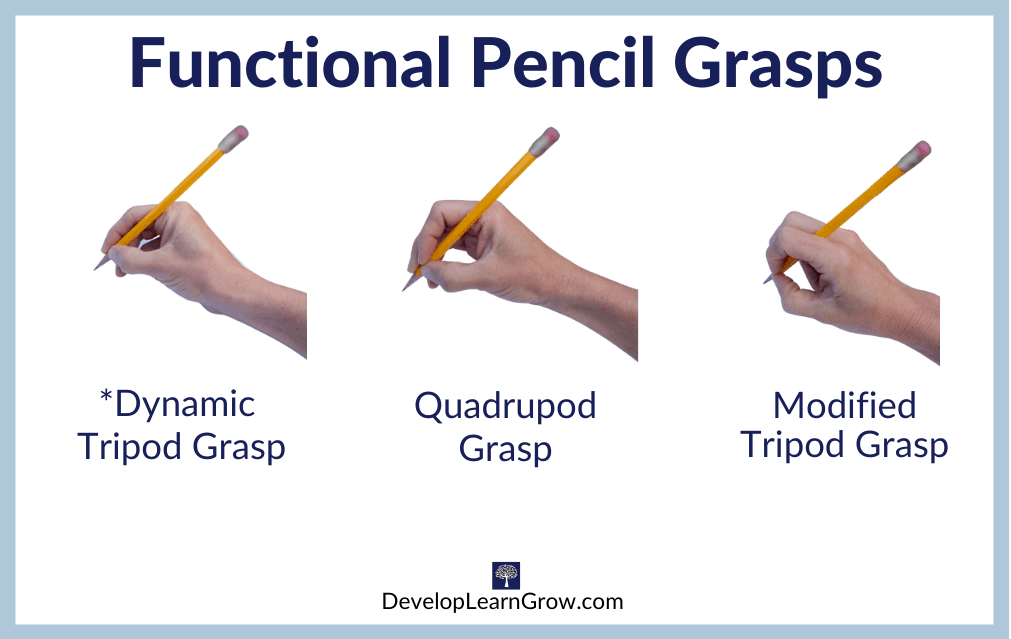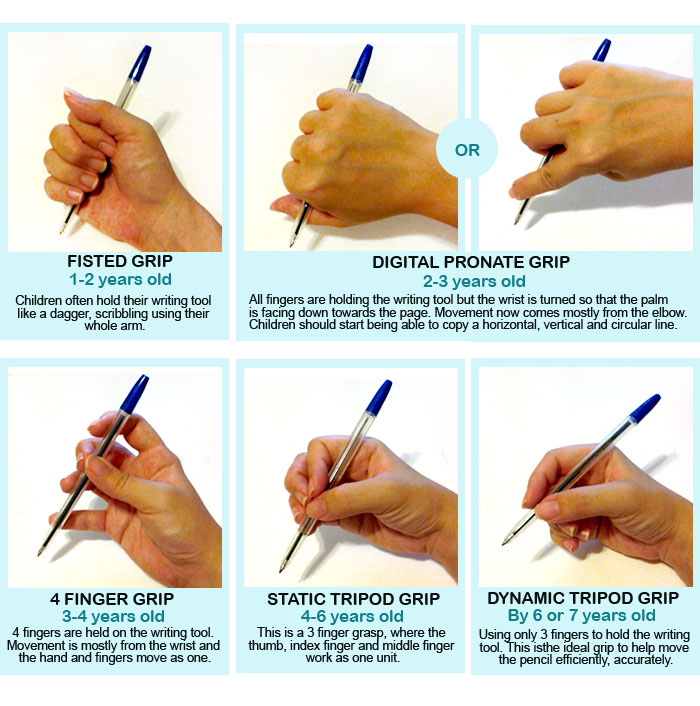
Pencil Grasp Development in Kindergartners Pencil grasp, Pencil grasp development, Kindergarten
Activities to Build Strength for Pencil Grasp Development. Building hand and finger strength is an important stepping stone to holding a pencil. Here are some fun ways that you can help your kids build strength in their little fingers. Playdough: Playing with playdough is a great way to build hand and finger strength.

Development of Pencil Grasp How to Promote a Functional Grasp with 5 Types of Activities
The pencil is gripped between the thumb and pointer finger and rests against the middle finger (in the tripod position). In the quadruple position, the middle finger also grips the pencil. The ring finger is the resting finger. The dynamic grasp is the final of the pencil grip stages. The child does not need to move the wrist much, and the arm.

Pencil Grasp Development in Kindergartners Pencil grasp, Pencil grasp development, Kindergarten
Developing a pencil grip typically happens in a predictable pattern but may not always progress this way and that is okay! Typically, a child will develop a whole hand grasp known as a palmar supinate grasp around 1-1.5 years of age. By the age of 2-3 a child will develop a digital pronate grasp where the writing utensil is held in the hand.

An occupational therapist explains what types of pencil grasp are expected at what ages, from 1
STATIC TRIPOD GRASP. A static tripod grasp will be seen between 3 to 4 years old, as a child is perfecting the tripod grasp. It is a three-finger grasp and includes the index and thumb, with the writing utensil resting on the middle finger, The rest of the fingers are tucked into the palm. Static refers to how the child moves the pencil.

Pinterest Pencil grasp development, Pencil grasp, Motor skills activities
Typical Pencil Grasp Development in Kids. Crude Palmar Grasp - 3-5 Months Old. Palmar Grasp - 6 Months Old. Radial Palmar Grasp - 7 Months Old. Raking Grasp - 8 Months Old. Radial Digital Grasp - 8-10 Months. Inferior Pincer & Pincer Grasp - 10 Months Old. Palmar Supinate Grasp - 12-15 months old.

Easy Fine Motor Activity for Toddlers Preschool, Preschool writing, Fine motor
The primitive pencil grasp is the initial way children grab a pencil. Sometimes you will hear this called the fist grasp. This type of grasp is often seen in children around 1-1.5 years old. Typically, they hold the pencil with their whole hand and use arm to make motions. Their motions are probably pretty uncontrolled at this stage of development.

17 Best images about Handwriting on Pinterest Fine motor, Writing skills and Writing
The development of a child's pencil grip, however, is a gradual process that will develop as the child grows. Stages of a pencil grip. There are 6 developmental stages of a maturing pencil grip but it is important to remember that while these stages are 'typical 'every child is different and will develop in their own way and at their own speed.

Functional and efficient Pencil Grasp. Dynamic Tripod, dynamic quadrupod, lateral tripod
Palmar supinate grasp is the first stage of pencil grasp development. In this grasp, your kid holds a pencil or a crayon with their entire hand, including their thumb. The palm nearest to their pinky will remain closest to the paper. The writing utensil will remain at a 90-degree angle to the surface, making the crayon or the pencil completely.

10 tips and tricks for a great pencil grip liz s early learning spot Artofit
Stage 4 to 5. Your child may not develop a three-finger tripod pencil grip until they are 5 - 6 years old. This is considered the most appropriate pencil grip, for right and left-handed writers, as it allows the fingers and wrist to work together to provide a more free-flowing movement. If your child is age 6+ years old and is using a stage 1.

Pencil Grasp Development in Children
This grasp commonly begins to develop around 2-3 years of age. # 3. The Static Tripod and Quadruped Grasp. There once was a time that the Tripod grasp was the only "right" way to hold a pencil. It allows for easy finger movement which impacts writing endurance and writing legibility. But that is not the case anymore.

instructions on how to use fingernails for different types of hands and fingers, from the
A child develops this grasp typically around 2 - 3 years old. The child will continue to use whole arm movements to scribble with this grasp. Static Tripod or Quadrupod Grasp: From ages 3½ - 4 years old, your child may move on to hold the pencil with 3 fingers (tripod grasp with index, middle finger and thumb) or four fingers (quadruped.

Pencil Grip Stages What to Expect & How to Help Your Kids
This stages of pencil grip poster can be used to help teachers or parents become familiar with the different stages of pencil grip. The poster outlines what each child should be able to do at different ages. The poster starts at 1 years old and works its way up to 7 years old. Some children develop their fine motor skills at different stages.

Your Kids OT blog Your Kids OT Pencil grasp, Handwriting activities, Hand therapy
Pencil Grip EYFS. Find out about the process children follow to develop a secure and strong pencil grip for writing and drawing. This guide for parents is perfect for helping you identify developmental stages and support your child's fine motor development. See the video below for more help with this important topic.

The Development of Appropriate Pencil Grip and Drawing Skills Ages 1 6 Pencil grip, Pencil
2. Static Tripod Grasp- (3.5-4 years)-Child holds the writing utensil with the thumb, pointer finger, and rests the utensil on the last joint of the middle finger.The ring finger and pinkie fingers are tucked into the palm of the hand. 3. Other grasp patterns- There can be many variations of grasp patterns that occur in the transitional stage, marked by the use of the wrist or forearm to move.

Pencil Grasp Development In Toddlers Pencil grasp development, Pencil grasp, Pencil grip
Moving through the different stages of pencil grasp development is an important part of childhood development. There are principles of development called " big to small " and " proximal to distal " (Myers) Basically this means that children develop control over the larger muscles of the trunk and arms which are closer to the body centre (proximal) before the smaller muscles of the.

Pin on Fine Motor Skills
Find out about the process children follow to develop a secure and strong pencil grip for writing and drawing. This Pencil Grip Guide for parents is perfect for helping you identify developmental stages and support your child's fine motor development. If you want to know more, why not check out the video below for more help with this important topic. Always remember to allow your child to.